
Your Guide to Managing Different Generations in the Workplace
One of the goals of effective management is to create a positive work environment for everyone. In today's fast-paced business world, many leaders manage a workforce that spans multiple generations.
It's now common to see a wide variety of ages in the workplace, from seasoned professionals over 70 to recent college graduates just starting their career. This blend of generations, while dynamic, brings unique challenges. Overcoming these can boost both employee productivity and company growth.
Knowing the generational background of your team members can sharpen your management skills. Let's look at four generations commonly found in the modern workplace.
-
Baby Boomers: Known for their strong work ethic, they value job security and are likely to stay with one employer for many years.
-
Generation X: Having strong work-life balance values, Generation X often displays traits of independence and resourcefulness, which makes them self-sufficient in the workplace.
-
Millennials/Generation Y: Driven by collaboration and technology, Millennials appreciate constant feedback and a socially conscious workplace.
-
Generation Z: True digital natives, Generation Z prioritizes a creative, inclusive work environment and values the ability to integrate work with their digital lifestyle.
Each generation has its unique traits that affect how they work and interact. Here are six tips to help you manage a multi-generational team effectively.
Get to Know Your Staff Demographics
Understanding your team demographics is the first step to effective multi-generational management.
Utilize analytic tools to examine the data at hand. This analysis will offer valuable insights about your employees. When studying the data, group them into categories and identify patterns that can aid in unlocking their full potential, advancing your brand's success.
Leading brands like Google and Microsoft employ "people scientists" to gain a comprehensive and precise view of their workforce. A reliable way to gather data from employees is through online pulse surveys.
In these surveys include questions that can help you to understand your employees' unique needs and expectations. Ask about their communication preferences, goals, and career paths.
The information gathered will aid you in segmenting people effectively and will be priceless input for your HR managers. It should be evident that attempting to alter employees' natural traits isn't productive. The best approach to managing diverse employee groups is to coach the managers to interact respectfully with each group.
Encourage Mentorship Across Generations
Teamwork plays a critical role in your brand's success. One proven method to foster a positive work environment is by creating opportunities for employees of different generations to interact and exchange ideas.
Establish a two-way mentoring program where older employees from the Baby Boomer and X generations guide younger staff from generations Y and Z.
Employees with more years under their belts often have a deep understanding of the company and its customers. Their wisdom can be instrumental in helping younger employees refine their interpersonal and communication skills.
On the other side, younger employees can guide their older counterparts in using contemporary digital tools, such as social media and project management tools like Slack, Jira, and Confluence.
Such collaborative efforts can significantly boost productivity and position the company to meet its short and long-term goals.
Promote Flexible and Mixed Communication Strategies
Successful communication is crucial in a diverse workplace, and appreciating the different preferences across generations can significantly improve teamwork.
While Baby Boomers lean towards traditional channels like face-to-face meetings or phone calls, Millennials and Gen Z gravitate to digital platforms and instant messaging.
To address this, implement a mixed communication strategy. This means using a blend of traditional and digital channels in your workplace. For example, use emails for general information, instant messaging for quick updates, and face-to-face meetings for detailed discussions. Encourage employees to be flexible and leave their comfort zones to communicate effectively with their peers. This could mean a Baby Boomer learning to use a chat app or a Gen Z team member taking a phone call.
Ensure all communications are clear and concise. Make important messages easily accessible to everyone across all channels.
This communication approach respects all generations' preferences, encourages adaptability, and promotes better understanding and collaboration within the team. This way, everyone is on the same page, working towards the shared goal of your company's success.
Build a Culture of Collaboration
In a multi-generational environment, building a culture of collaboration is essential. It encourages employees of all ages to work together, share their unique ideas, and learn from each other.
Start by highlighting the value each generation brings to the team. Recognize the experience and wisdom of older generations and the fresh perspectives and tech-savviness of the younger ones. This mutual respect serves as a foundation for solid teamwork.
Create opportunities for team projects that involve a mix of generations. Working together on shared objectives allows employees to understand better each other's strengths and work styles.
Ensure your workspace is designed to encourage teamwork. This could be open-plan areas for group discussions, quiet spaces for focused work, or digital platforms for remote team collaboration.
Remember, collaboration is about more than just working together. It's about creating a workplace where every generation feels valued and heard. By cultivating a collaborative culture, you're enhancing job satisfaction and productivity.
Understand What is Respect for Different Generations
Respect is crucial for every employee. It promotes engagement, motivation, and commitment. However, many managers may not realize that perceptions of respect can vary across generations.
Baby Boomers appreciate interpersonal relationships. They feel respected when you engage with them directly and discuss matters in person.
For Millennials, inclusion in the decision-making process signals respect. They want their insights to be considered in important decisions. Ignoring their input could be perceived as a sign of disrespect.
Members of Generation X highly value the concept of "work-life balance" — a term they pioneered. They appreciate a balanced approach to tasks where they can perform at their best without being overwhelmed. Respecting their time and providing a manageable workload will help to maintain their productivity and job satisfaction.
Meanwhile, Generation Z values autonomy. They feel respected when entrusted with new tasks and given the freedom to approach them their way. Be clear and concise in your instructions and avoid unnecessary details to demonstrate respect for their work style.
Understanding these varying views on respect can greatly improve your management of a multi-generational workforce, enabling a more pleasant and productive environment.
Address Personal Needs and Aspirations of Your Team
Multi-generational teams bring varied perspectives. This can lead to innovative solutions. But it also means different needs and aspirations.
Baby Boomers may be looking toward retirement. Generation X might be seeking leadership roles. Millennials could be chasing skill growth. Generation Z might want job stability. Understanding these needs is crucial.
Making small adjustments can lead to big wins. For example, offering flexible work hours could boost a Millennial's productivity. Offering extra health benefits could retain a Baby Boomer.
Meeting employees' needs doesn't mean compromising results. It means creating conditions where each team member can work most effectively.
Proper management of a multi-generational team is crucial to your organization's success. Understanding each generation's distinct needs, preferences, and aspirations is essential. Keep in mind that a diverse workforce is not a challenge to overcome but a resource to be valued. The richness of ideas, creativity, and innovation that comes from multiple generations working together can be a unique strength that sets your team apart. So, lean into these differences, celebrate them, and use them as a springboard for growth and development.

